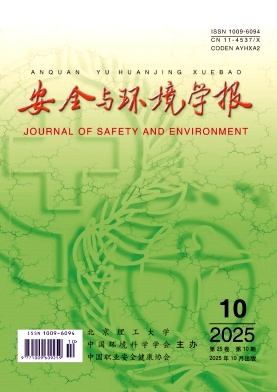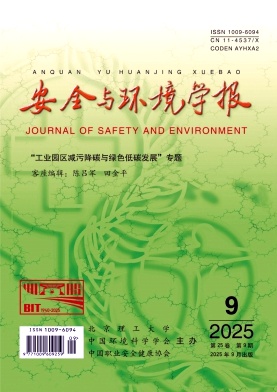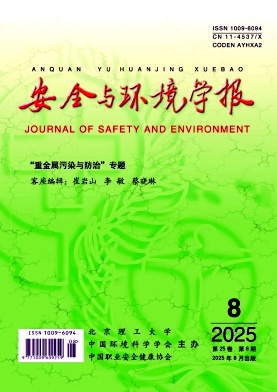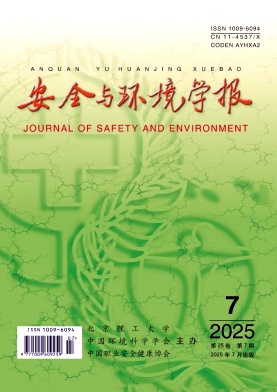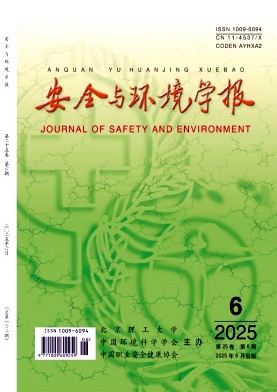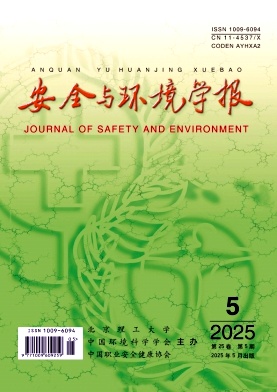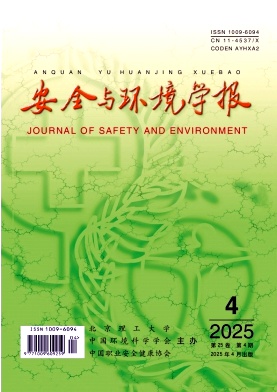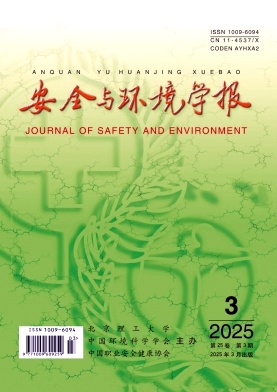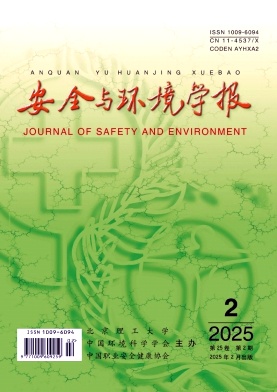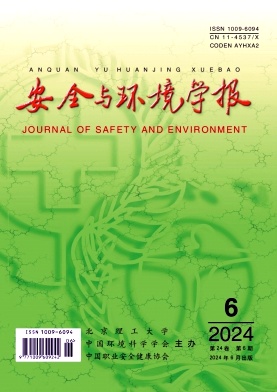Tracking the information about your manuscript
Communicate with the editorial office
Query manuscript payment status Reviewer LoginOnline Review
Online Communication with the Editorial Department Author LoginCollecting, editing, reviewing and other affairs offices
Managing manuscripts
Managing author information and external review Expert Information
Downloads
Page Views
Page visits today: 51
About the Journal
 Superintended by:China North Industries Group Corporation Limited
Superintended by:China North Industries Group Corporation Limited
Sponsoredy:Beijing Institute of Technology, Chinese Scoiety for Environmental Sciences, China Occupational Safety and Health Association
Edited & Published by: Editorial Department of Journal of Safety and Environment
Issues per year: 12
ISSN 1009-6094
CN 11-4537/X
Rapid assessment of seismic resilience in substation systems using machine learning
WANG Kaige;ZHENG Shansuo;YANG Feng;ZHOU Lin;TIAN Qi;CAI Guowei;This study tackles the computational inefficiency of Monte Carlo(MC) simulations in evaluating substation system resilience. We propose a machine learning-based approach for the rapid assessment of seismic resilience in substations. In this framework, the substation is modeled as a topological network that integrates both structural and functional units. Additionally, we analyze the correlation between physical damage to electrical equipment and the occurrence of cascading failures within the substation. Service path information was captured using transitive closure, and uncertainties in equipment recovery times were incorporated into the modeling process. To expedite the MC simulations, a surrogate modeling approach was introduced. The functional assessment was reformulated as a multi-class classification problem, considering physical-functional constraints. Support Vector Machine(SVM) and logistic regression models were developed to map the damage function and predict system performance. Stochastic damage scenarios, incorporating uncertainties in equipment failures, were constructed as feature inputs. Supervised learning was then conducted using eleven discrete operational states of the substation as training labels to train the surrogate model. The method was validated on a 220 kV double-bus electrical main connection system. The results indicate that the system resilience index converges once the sample size of damage-function states reaches 3 000. The linear kernel SVM and logistic regression models were trained using 5 000 sample sets under varying Peak Ground Acceleration(PGA) conditions, achieving prediction accuracies of 96.6% and 96.9%, respectively. The trained surrogate models were then applied to the resilience assessment, showing that the robustness and recovery time distributions of the substation under different PGAs closely match those obtained from MC simulations. The resilience deviations remained below 0.009, thereby validating the reliability of the proposed method. Additionally, a comparative analysis of time complexity reveals that the Warshall algorithm requires O(n3) for an n-node system, while the time complexity of the surrogate model, relying on linear kernel SVM or logistic regression during prediction, operates at O(n). This demonstrates the computational efficiency of the proposed method. The results confirm that this approach significantly enhances the efficiency of substation resilience assessment without compromising accuracy.
Research on the combined application of text mining and fuzzy analytic hierarchy process in risk assessment
XIU Changkai;LIU Guoan;XIAO Peng;BAI Ning;MA Xiaoshan;To accurately identify the key risk factors in building construction, this paper proposes a two-phase risk assessment model that combines text mining and the fuzzy analytic hierarchy process, tailored to the specific characteristics of the construction industry. In the first phase, text data from hidden danger investigations during building construction are classified according to the type of hazard.Each identified hazard is then weighted using a danger evaluation method to determine its risk weight. Next, the weighted text data is analyzed using data mining techniques with VOSviewer text mining software. A co-occurrence network diagram of keywords related to the problematic hidden dangers is constructed, and preliminary risk assessment results are obtained. However, there are limitations to relying on a single method: on one hand, the data from hidden danger investigations during construction are often incomplete; on the other hand, risk assessment results derived solely from problematic hazard data lack both systematization and foresight. Therefore, in the second phase, the Fuzzy Analytic Hierarchy Process(FAHP) is introduced to refine and adjust the preliminary risk assessment results by incorporating expert opinions. This approach analyzes the risk weights of factors in both the primary and secondary indicator layers within the construction risk assessment system. The risk weights of secondary indicators are synthesized and normalized to obtain optimized risk assessment results. Additionally, an intuitive network diagram of risk category co-occurrence and a risk category density map are constructed to enhance the visualization and comprehensiveness of the assessment. This study compares the risk weights of secondary indicator factors before and after optimization and validates the feasibility of the proposed model through case analysis. The primary contribution of this research lies in integrating multiple methods and strengthening the combination of quantitative and qualitative analysis. This approach addresses the limitations of text mining, such as incomplete risk factor data and the inability of simple word frequency statistics to accurately reflect real risk levels. Simultaneously, it overcomes the shortcomings of expert scoring, which often lacks empirical data support. The findings of this study provide a valuable reference for risk assessment in building construction.
Study on the evolution of coal mine gas explosion risk from the perspective of safety information loss
CHENG Lianhua;JIANG Meng;GUO Huimin;ZHU Wenyu;This paper analyzes 65 gas explosion accidents to investigate the occurrence and frequency of safety information loss risk factors in coal mine gas explosions. It evaluates the transmission process of safety information and its loss at various stages. The study utilized a questionnaire method to gather foundational data and employed Pearson's correlation coefficient to assess the relationship between the importance of risk factors and their actual frequency. A comprehensive correlation was achieved by weighting these two dimensions. By integrating the results of correlation mining as edge weights and applying complex network theory, a risk evolution weighted network for safety information loss in gas explosions has been constructed. The static topological characteristics of this network, including node degree, closeness centrality, and betweenness centrality, were analyzed to identify key risk factors. Additionally, a cascading failure model was developed to simulate the risk evolution of each node within the network, allowing for the identification of critical nodes and their corresponding risk evolution paths. The results indicate that:(1) The loss of safety information at various stages, such as the absence or error of original information, the distortion of original information into carrier information, the abnormal perception and understanding deviation by the information recipient, and untimely responses or execution errors, can lead to gas explosion accidents. The frequency of risk factors during the stages of safety information execution loss and safety information cognition loss is notably higher, accounting for 28.08% and 21.59%, respectively. These stages represent vulnerable links in the safety information transmission process.(2) A strong correlation exists between the risk factors of gas explosion accidents, with 99 corresponding strong correlations identified. The topological characteristics at the node level of the risk evolution network were analyzed, revealing the comprehensive values of key risk nodes as follows: personnel safety awareness(0.640), production operation compliance(0.638), personnel certification status(0.621), labor discipline compliance(0.536), and the occurrence of friction and electric sparks(0.524). These nodes exhibit significantly higher topological characteristics in the stages of cognition and execution loss compared to other stages of information loss.(3) In the key risk evolution path, the occurrence of friction and electric sparks, control of gas overrun situations, production operation compliance, production command compliance, and the safety awareness level of personnel are prominently featured across all risk evolution paths. These findings align with the key risk factors identified through the analysis of the network's static topological characteristics. These nodes are critical in the evolution of risks and play a significant role in the overall safety of the system.
Impact of H_2S on the adsorption of CH4, CO2, and N2 in gas-fat coal
ZENG Mingrong;LU Dongxiang;ZHOU Xihua;BAI Gang;BAI Qihui;Investigating the influence of hydrogen sulfide(H_2S) on gas adsorption characteristics is crucial for the effective management of H_2S in coal seams that contain this compound. This study employed Grand Canonical Monte Carlo(GCMC) simulations using Material Studio software to explore the adsorption behaviors of Jixi(JX) gas-fat coal toward single-component gases(H_2S, CH4, CO2, N2) as well as binary-component gas mixtures(H_2S/CH4, H_2S/CO2, H_2S/N2). Molecular models of JX coal, with varying H_2S proportions(ranging from 0 to 2.0%), were developed to assess its impact on the adsorption of CH4, CO2, and N2. The results revealed significant differences in the adsorption capacities of the gases: H_2S exhibited the highest adsorption capacity, followed by CO2, CH4, and N2. As the temperature increased from 273.15 K to 333.15 K, the adsorption amounts of H_2S, CH4, CO2, and N2 decreased by 5.13%, 22.62%, 14.88%, and 29.15%, respectively. These findings confirm that temperature has the least impact on H_2S adsorption, while it exerts the greatest influence on N2, which is primarily governed by physical adsorption. In binary-component competitive adsorption scenarios, H_2S exhibited preferential adsorption behavior, with its saturated adsorption capacity approximately 10.28 times higher than that of CH4, 12.55 times greater than that of N2, and 1.77 times higher than that of CO2. At a pressure of 20 MPa, the presence of H_2S(ranging from 0 to 2.0%) reduced the adsorption capacities of CH4, CO2, and N2 by 24.77%, 18.66%, and 21.90%, respectively, with CO2 adsorption being the least affected. The interaction energies between CH4/N2 and coal were primarily governed by van der Waals forces, while CO2 interactions involved both van der Waals and electrostatic forces. The results demonstrate that the presence of H_2S significantly reduces the adsorption performance of the adsorbate gases CH4, CO2, and N2. This study offers valuable insights for developing effective H_2S control strategies in coalbed gas exploitation.
Engineering application study of CO_2-N2 composite inert gas for prevention and control of coal spontaneous combustion in goaf
WU Chunlei;SHI Bobo;XUE Yong;GUO Qingxu;This study presents a comprehensive evaluation of the CO_2-N2 composite inert gas for effectively suppressing coal spontaneous combustion in the goaf of the 2301 fully mechanized caving face at Yangcheng Coal Mine. Three distinct gas injection methods were tested:(1) N2 injection: ground-based membrane separation units(DM-2000 and DM-1000) generated N2 with a purity of >97%, offering adjustable flow rates between 1 000-2 000 m3/h.(2) Gaseous CO2 injection: liquid CO2 was vaporized using an EDM-1000 system, achieving a flow rate of 700-1 000 m3/h with 100% purity.(3) CO_2-N2 composite gas injection: a gas compounder mixed N2 and CO2 in a 4:6 ratio, achieving a total flow rate of 1 300-1 500 m3/h(CO2: 520-600 m3/h, N2: 780-900 m3/h). A portable sensor detection method was utilized to measure the gas volume fraction in the return air corner and the return air flow. The results indicated that merely increasing the N2 flow rate(for example, from 800 m3/h to 2 000 m3/h) was often inadequate to lower the CO volume fraction in the return air and return air corners below the safe threshold. Pure CO2 injection effectively reduced the CO volume fraction to below 24×10-6 within 10 days. However, the CO_2-N2 composite inert gas demonstrated superior performance, lowering the CO volume fraction in the return air corner to below 24×10-6 within just 5 days—50% faster than pure CO2. This enhanced performance can be attributed to the synergistic mechanism of rapid N2 diffusion and deep CO2 penetration, which optimized the suppression effect. Safety assessments revealed that the maximum CO2 volume fraction in the return airflow during composite gas injection was 0.67%, significantly lower than the 1.12% observed with pure CO2, thus meeting China's safety standard of <1.5%. The economic analysis revealed a 30.35% cost reduction when using the CO_2-N2 composite gas compared to pure CO2, driven by optimized gas ratios and decreased CO2 consumption. These findings validate the technical feasibility, safety, and cost-effectiveness of CO_2-N2 composite gas as a viable solution for fire prevention in goaf under similar mining conditions.
News
Links

